
The Writings of Eloise Butler
Milkweed Flowers Much in evidence during July, Harebells, Ox-Eyes, and Water Lilies Also Bloom in Abundance.
Published in the Minneapolis Sunday Tribune July 9, 1911
[Note: To facilitate identification of plants, we have taken the liberty of adding the information that is within brackets and also all the botanical names have been put into italics. The language of Eloise's day is left as written. Additional notes at the bottom of the page.]
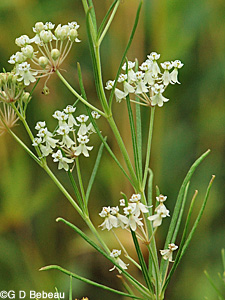
At present the flowers most in evidence are the milkweeds. About a dozen species of them are indigenous to Minnesota. Every one knows the tall, rank, Common Milkweed [Asclepias syriaca] and probably admires more than the large umbels of pale purplish flowers the rough, gray seed pods, that, splitting down one side, disclose a wondrous freight of closely packed, brown seeds. A gust of wind quickly twirls these out; for each seed, in place of a magic carpet is provided with a tuft of white, silky down to transport it to some distant place.
The first milkweed to appear was the oval-leafed, white-flowered species of the prairies [Oval-leaf Milkweed, Asclepias ovalifolia Decne.] This has been succeeded by another species [Asclepias vericillata, the Whorled Milkweed] with smaller white blossoms and threadlike leaves. Meadows and treeless swamps are gay with large masses of a rose colored milkweed [Swamp Milkweed] Asclepias incarnata; and sandy banks and roadsides are fairly ablaze with red and orange A. tuberosa, which has been successfully transferred to gardens. It is rightly named Butterfly Weed, not only because the flowers attract hosts of butterflies, but because they vie with them in gorgeous coloring. Another name, pleurisy root, recalls the alleged medicinal properties of the milkweeds that gave rise to the scientific name Asclepias - a modification of the name of the ancient physician Aesculapias.
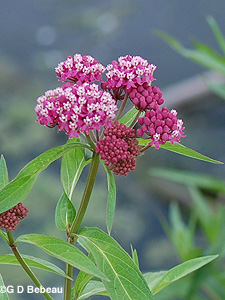
Most of the milkweeds, as the term implies, are furnished with a copious, milky juice. Crawling insects are likely to be covered and impaled by this sticky fluid, which exudes from wounds made by their sharp claws, as they scale the stems of the plants, and thus prevents them from rifling the nectar provided by the flowers for the pollen-distributing, hairy-bodied flying insects.
Wonderful are the adaptations of the flower to desirable insect guests. Above the petals is a crown of five hood-like nectaries, each bearing within a slender, inverted horn. The center of the flower is designedly slippery.
When an insect alights on this slimy surface to sip the abundant nectar, her feet slip and are tightly caught in crevices, also of fell design. When she extricates her toes, so to speak, she drags out attached to them a dangling pair of pollen masses - pollinia, a part of which is sure to adhere to the pistil of the next milkweed flower she visits. Insects have been caught at this season with stalks of these pollinia attached to every one of their six feet.
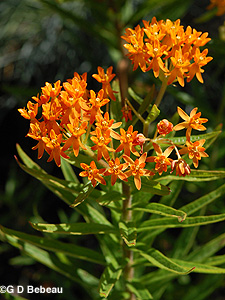
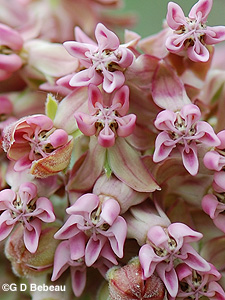
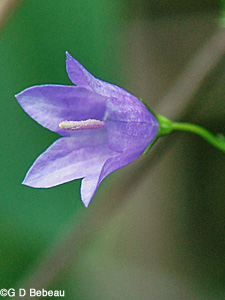
In contrast with the robust milkweed, peeps out from rocky, wooded banks, the drooping, purplish Blue Harebell [or Bluebell Bellflower], swaying on its slender stalk. It is identical with the bonny bluebell o’ Scotland, so often alluded to in Scottish literature. One might wonder on seeing the slender, attenuated leaves why the plant is called Campanula rotundifolia. The rotund leaves are the first comers, and generally die away before blossoming time. (Note 1)
Particularly under cone-bearing trees may be found the false wintergreen, or Pyrola (Note 2). The somewhat round and thick leaves of this plant do not rise far above the ground; the sweet, waxy white or pinkish flowers are arranged in wand-like racemes. To think of this plant in its native haunts sets the gypsy blood a coursing for a tramp in the wild to breathe the air from the pines and to crush their needles under foot.

After the Pasque flower, our most conspicuous anemone is the canadensis [Anemone canadensis, Canada Anemone], once known as the pennsylvanica. On account of a similarity of leaf it is often taken for a white geranium. The flower, however, has an entirely different structure from that of the geranium. The anemone, for instance, has no corolla; the white floral leaves are sepals. The Garden Magazine for July has a paper on anemones, especially recommending this species for plantings, and emphasizing the value of white flowers for harmonizing discordant colors and for toning down the hot and violent reds and yellows and outrageous magentas.
The meadows and copses are now wild with the ox-eye (Heliopsis) [Smooth oxeye, Heliopsis helianthoides], much like the wild sunflowers, and distinguished from them only by the specialist in a few details. The ox-eye is a forerunner of the golden seas of bloom that characterize the waning summer. It is to be commended for its profuse growth and for its adaptability to varying conditions.

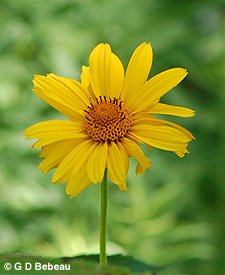
For coolness, rest and peace go to the lakes encircled and islanded by the refreshing white lilies serenely resting on the surface of the water among the large, round leaf pads. These lilies of the water toil not, neither do they spin. They are, indeed, lotuses with power like those of the Nile to induce dreams and visions. The flowers are closed at night. At sunrise, if one chances to be at a lily pond, he will be entranced to see the flowers, burst open all at once under the influence of the sun - a sudden transformation of the dark water into a scene of enchantment.
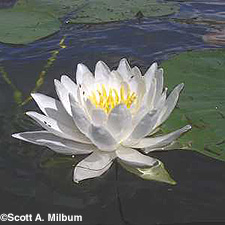
The pond lily of this vicinity [American Water Lily, Nymphaea odorata ssp. tuberosa] (Note 3), has but little fragrance compared with that of the East. The stout, subterranean stem scarred with the evidence of former leaf and flower stalks has also tubers which break off to propagate new plants. The pond lily is of special scientific interest because it illustrates Goethe’s theory that all the parts of a flower are modified leaves. The green sepals merge into the white petals, and they, in their turn, into broad yellow stamens, which become narrower toward the center.
Somewhat stiff and coarse by the side of the white lily is the Yellow Cow Lily [Yellow Pond Lily, Nuphar lutea ssp. variegata], a plebeian, if you please, but a pleasing foil to the patrician beauty. Nevertheless anyone would admire the flower of the wee cow lily, measuring less than an inch across. This species is common in Nova Scotia and New Brunswick and has been reported in Minnesota.
Notes:
1. Campanula rotundifolia. Eloise Butler first planted this species in the Garden in 1908. Martha Crone planted it in 1933.
2. We believe she is referring to Pyrola asarifolia Michx., now reclassified as Pyrola americana Sweet, called American Wintergreen. Eloise Butler first planted this species in the Garden in 1909 and 1910.
3. Nymphaea odorata was planted in the Garden in 1933 at the newly created Mallard Pool. These had been obtained by Eloise Butler the previous fall and heeled in at Mrs. Babcock’s house. Eloise passed away before she could plant them in the spring. Martha Crone did the job.
Tours to the Garden. The following was also printed at the beginning of the article.
Miss Butler will conduct parties through the Wild Botanic Garden in Glenwood Park, Tuesday and Wednesday mornings, meeting them at the terminus of the Fourth and Sixth avenue north street Railway, Sixth avenue north and Russell Avenue, at 10 o'clock. Also Saturday & Sunday afternoon, meeting then at 2:30 o'clock at the same place. One hour later on the same days, persons coming by automobile or carriage will be met at the entrance to the Garden, on the boulevard, at a point northeast of Birch Pond in Glenwood Park. To reach Birch Pond, turn in at the left on Western Avenue where the Park Boulevard intersects the avenue.
More information and photos on some of these plants can be found under these links:
Butterfly Weed
Canada Anemone
Common Milkweed
Harebell
Smooth Oxeye
Swamp Milkweed
Whorled Milkweed